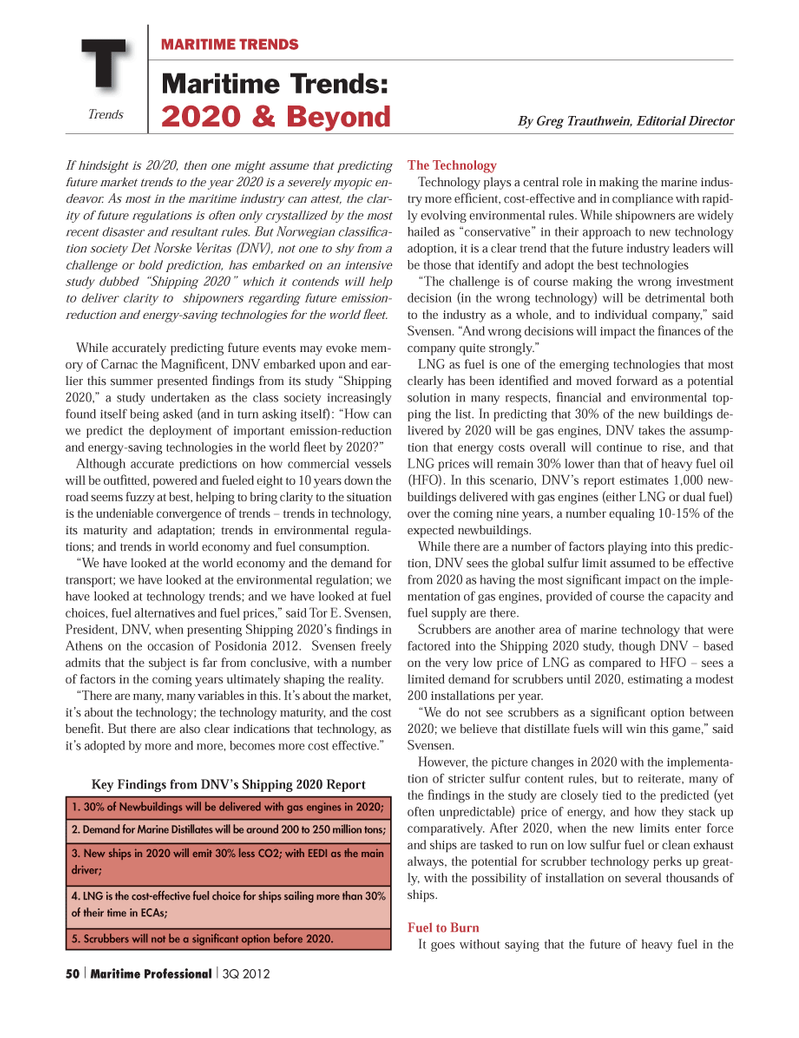
Page 50: of Maritime Logistics Professional Magazine (Q3 2012)
Classification Societies, Quality & Design
Read this page in Pdf, Flash or Html5 edition of Q3 2012 Maritime Logistics Professional Magazine
Trends If hindsight is 20/20, then one might assume that predicting future market trends to the year 2020 is a severely myopic en- deavor. As most in the maritime industry can attest, the clar- ity of future regulations is often only crystallized by the most recent disaster and resultant rules. But Norwegian classiÞ ca- tion society Det Norske Veritas (DNV), not one to shy from a challenge or bold prediction, has embarked on an intensive study dubbed ÒShipping 2020Ó which it contends will help to deliver clarity to shipowners regarding future emission- reduction and energy-saving technologies for the world ß eet. While accurately predicting future events may evoke mem- ory of Carnac the MagniÞ cent, DNV embarked upon and ear- lier this summer presented Þ ndings from its study ÒShipping 2020,Ó a study undertaken as the class society increasingly found itself being asked (and in turn asking itself): ÒHow can we predict the deployment of important emission-reduction and energy-saving technologies in the world ß eet by 2020?Ó Although accurate predictions on how commercial vessels will be outÞ tted, powered and fueled eight to 10 years down the road seems fuzzy at best, helping to bring clarity to the situation is the undeniable convergence of trends Ð trends in technology, its maturity and adaptation; trends in environmental regula- tions; and trends in world economy and fuel consumption. ÒWe have looked at the world economy and the demand for transport; we have looked at the environmental regulation; we have looked at technology trends; and we have looked at fuel choices, fuel alternatives and fuel prices,Ó said Tor E. Svensen, President, DNV, when presenting Shipping 2020Õs Þ ndings in Athens on the occasion of Posidonia 2012. Svensen freely admits that the subject is far from conclusive, with a number of factors in the coming years ultimately shaping the reality. ÒThere are many, many variables in this. ItÕs about the market, itÕs about the technology; the technology maturity, and the cost beneÞ t. But there are also clear indications that technology, as itÕs adopted by more and more, becomes more cost effective.Ó Key Findings from DNV?s Shipping 2020 Report The Technology Technology plays a central role in making the marine indus- try more efÞ cient, cost-effective and in compliance with rapid- ly evolving environmental rules. While shipowners are widely hailed as ÒconservativeÓ in their approach to new technology adoption, it is a clear trend that the future industry leaders will be those that identify and adopt the best technologiesÒThe challenge is of course making the wrong investment decision (in the wrong technology) will be detrimental both to the industry as a whole, and to individual company,Ó said Svensen. ÒAnd wrong decisions will impact the Þ nances of the company quite strongly.Ó LNG as fuel is one of the emerging technologies that most clearly has been identiÞ ed and moved forward as a potential solution in many respects, Þ nancial and environmental top- ping the list. In predicting that 30% of the new buildings de- livered by 2020 will be gas engines, DNV takes the assump- tion that energy costs overall will continue to rise, and that LNG prices will remain 30% lower than that of heavy fuel oil (HFO). In this scenario, DNVÕs report estimates 1,000 new- buildings delivered with gas engines (either LNG or dual fuel) over the coming nine years, a number equaling 10-15% of the expected newbuildings. While there are a number of factors playing into this predic- tion, DNV sees the global sulfur limit assumed to be effective from 2020 as having the most signiÞ cant impact on the imple- mentation of gas engines, provided of course the capacity and fuel supply are there.Scrubbers are another area of marine technology that were factored into the Shipping 2020 study, though DNV Ð based on the very low price of LNG as compared to HFO Ð sees a limited demand for scrubbers until 2020, estimating a modest 200 installations per year. ÒWe do not see scrubbers as a signiÞ cant option between 2020; we believe that distillate fuels will win this game,Ó said Svensen. However, the picture changes in 2020 with the implementa- tion of stricter sulfur content rules, but to reiterate, many of the Þ ndings in the study are closely tied to the predicted (yet often unpredictable) price of energy, and how they stack up comparatively. After 2020, when the new limits enter force and ships are tasked to run on low sulfur fuel or clean exhaust always, the potential for scrubber technology perks up great- ly, with the possibility of installation on several thousands of ships.Fuel to Burn It goes without saying that the future of heavy fuel in the MARITIME TRENDSMaritime Trends: 2020 & BeyondTBy Greg Trauthwein, Editorial Director 1. 30% of Newbuildings will be delivered with gas engines in 2020;2. Demand for Marine Distillates will be around 200 to 250 million tons;3. New ships in 2020 will emit 30% less CO2; with EEDI as the main driver;4. LNG is the cost-effective fuel choice for ships sailing more than 30% of their time in ECAs;5. Scrubbers will not be a signiÞ cant option before 2020. 50 | Maritime Professional | 3Q 2012

 49
49

 51
51
